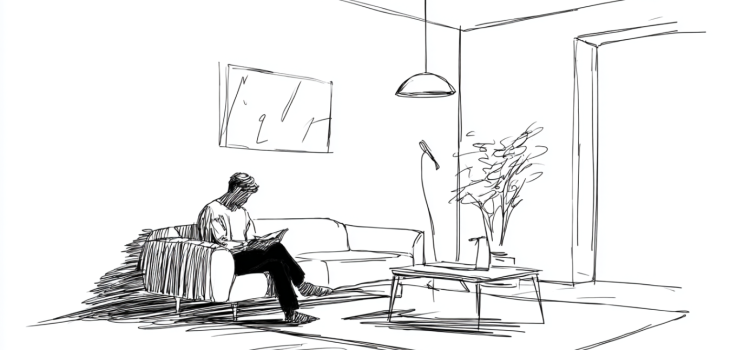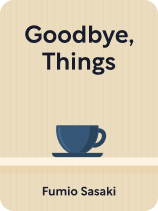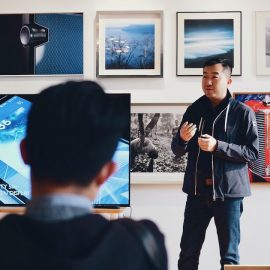

This article is an excerpt from the Shortform book guide to "Goodbye, Things" by Fumio Sasaki. Shortform has the world's best summaries and analyses of books you should be reading.
Like this article? Sign up for a free trial here.
Do you have a hard time getting rid of things? How might these things be holding you back from happiness?
In the book Goodbye, Things, Fumio Sasaki shares his story, arguing that you can be happier, freer, and more focused by eliminating clutter. He presents minimalism as more than simply an organizational strategy, but an entire approach to life that reshapes how you use your time and form relationships.
Keep reading for an overview of the book, along with practical advice for choosing what to discard and how to overcome the challenges of letting things go.
Goodbye, Things Book Overview
What if all the possessions you’ve accumulated are holding you back from a life of focus, purpose, and fulfillment? That’s what Tokyo-based editor and publisher Fumio Sasaki discovered in his journey toward a minimalist lifestyle. He made a conscious decision to throw away nearly all of his belongings, keeping only the bare necessities, and found that it transformed not only his personal space, but his entire life.
In his book Goodbye, Things (2015; first English edition: 2017), Sasaki shares his story, arguing that you can become a happier, freer, and more focused version of yourself by eliminating all the clutter in your life. He presents minimalism as more than an organizational strategy—instead, it’s an entire approach to life that reshapes how you use your time and form relationships. He also shares a wide range of practical advice for choosing what to discard and overcoming the emotional challenges of letting go of things once and for all.
Our guide explores Sasaki’s ideas in three parts:
Part 1: Why You Have Too Much Stuff defines minimalism and discusses the emotional reasons why you accumulate and hoard unnecessary things.
Part 2: Why Minimalism Makes You Happier explains all the ways that getting rid of things can transform your life for the better.
Part 3: How to Let Go of Possessions relates Sasaki’s tips for deciding what to part with and overcoming the emotional hurdles that get in your way.
Throughout, our commentary explores the psychological principles behind Sasaki’s ideas and compares his recommendations with those of other minimalists and decluttering experts like Marie Kondo (The Life Changing Magic of Tidying Up).
Part 1: Why You Have Too Much Stuff
Sasaki argues that most people have too much stuff. Maybe it’s a garage full of tools you never use, or a closet stuffed with clothes you haven’t worn in years, or a basement full of inherited furniture. How did you acquire all this stuff to begin with? Sasaki explains that most of your possessions come from attempts to fulfill emotional, not practical, needs. In this section, we’ll explore the emotional drives that motivate you to accumulate and hold onto these unnecessary possessions.
1) You Accumulate Things to Demonstrate Your Value
Sasaki argues that you accumulate new possessions to prove your worth to other people. For example, by owning expensive things like designer clothes or top-shelf electronics, you signal to others that you’re successful and important. By owning a large collection of records, you present yourself as a music aficionado, thus signalling your value through your taste. By owning a shed full of tools, you may be presenting yourself as someone who is good at DIY projects, and so on.
Furthermore, once you equate your worthiness with owning things, you become jealous of others who own nicer things, as it signals that they may be more intrinsically worthy than you. Therefore, you constantly compare your possessions to others’ so that you know where you stack up on the “worthiness scale,” and you accumulate even more things to catch up to those you perceive to be ahead of you.
2) You Accumulate Things Because Satisfaction Is Fleeting
Sasaki explains that you also accumulate more than you need because the satisfaction that comes from obtaining something new is so brief. It feels good to buy something that you’ve wanted for a long time, like a new computer or a new deck chair. However, the novelty will quickly wear off, and your purchase will no longer feel as exciting and satisfying as it first did. Rather than continuing to appreciate its value, you begin to desire something new again. Sasaki explains that this becomes an endless cycle of accumulating new possessions only to tire of them and desire something else, leaving your home cluttered with items you no longer use or appreciate.
3) You Hold Onto Things to Preserve Opportunities
Sasaki argues that you also hold onto things you don’t need because you’re trying to preserve opportunities. This happens when you have items that you’re planning or hoping to use someday—holding onto them is a way to hold onto that hope. For example, suppose someone starts a new baking hobby. They invest in rolling pins, baking cookbooks, and a stand mixer to support this activity. Then they lose interest and pursue other hobbies, but they keep all their baking supplies around because they believe that someday they’ll pick it up again. This habit keeps you holding onto possessions that go unused.
4) You Hold Onto Things to Preserve Memories
Lastly, Sasaki explains that you hold onto things you no longer need because you want to hold onto the memories you’ve attached to these objects. Gifts, souvenirs, and family heirlooms can be especially difficult to let go of. These items trigger memories and emotions related to important people and experiences, and you hold onto them because you’re afraid of losing those memories. However, Sasaki argues that your keepsakes don’t contain the memories. You can still remember these important people and experiences without holding onto the objects that remind you of them.
Part 2: Why Minimalism Makes You Happier
According to Sasaki, if you have too much stuff, you need to get rid of some of it. You can do this by embracing minimalism—an approach to life where you consciously decide to only own the bare necessities. To do this, you must consider the merit of each item you own—is it essential, or are you merely holding onto it for the emotional reasons outlined above? If it’s not essential, Sasaki encourages you to get rid of it. He elaborates that there isn’t a specific number of possessions someone needs to eliminate to become a minimalist, but that becoming a minimalist means making a personal choice about what you actually need.
Sasaki argues that getting rid of unnecessary belongings not only makes your home less cluttered, but that it leads to a more fulfilling, enjoyable, and purposeful life. He found that his own life transformed as he embraced minimalism. Sasaki achieved greater clarity of purpose, an improved mood, and more time and freedom than he had previously thought possible.
Benefit #1: Getting Rid of Possessions Gives You Clarity
Sasaki maintains that eliminating unnecessary possessions helps you clarify your values and sense of purpose. This is because choosing which items to eliminate requires you to repeatedly ask yourself what’s essential for your life, forcing you to reflect on your deepest priorities and commitments. For example, let’s say you have a large collection of old DVDs that you no longer watch. In reflecting on whether this is really necessary, you realize that you’re holding onto them to impress your friends with all the classic films you’ve seen. This moment of reflection helps you to realize that impressing other people isn’t as important as you once thought, and you can shift your focus to more meaningful lifelong goals.
Sasaki found that this increased clarity spilled over into many areas of his life. Here, we’ll take a closer look at how his attitudes toward possessions, relationships, and experiences changed as he adopted a minimalist lifestyle.
1) Enjoying Your Possessions More
Sasaki explains that getting rid of most of his possessions caused him to place a greater value on the possessions he still had. Each object he owned was something that he’d personally decided was essential to his life, so he valued it highly. Even though he had fewer possessions, he found that got more enjoyment out of them than he did before he became a minimalist.
2) Focusing on Quality Relationships
As Sasaki came to value the quality of his possessions over their quantity, this view impacted his relationships as well. Although many people strive to maintain superficial ties with a large number of people, embracing minimalism taught him to focus on maintaining deeper connections with fewer people instead. He explains that this mindset helps you cultivate deeper connections that enrich your life, leading to greater happiness and fulfillment.
3) Living in The Present
Furthermore, minimalism began to change the way Sasaki experienced life from moment to moment. He started living in the present instead of thinking about the future or the past. As he got rid of his possessions, he asked himself if he needed the object right now. If he was only holding onto an object because it might become useful in the future or because it reminded him of the past, he would let it go. This taught him to focus on the current moment. Over time, Sasaki found that living in the present helped him enjoy life more because he was getting more out of each experience by giving it his full attention.
Benefit #2: Getting Rid of Possessions Improves Your Focus
Sasaki also writes that he became calmer and more relaxed when he had fewer possessions. This is because, whether you realize it or not, your possessions make demands on your attention. For example, when you see a houseplant, you remember that you need to water it; when you see a book sitting out, you remember that you intended to read it. Whenever you see cluttered or dirty possessions, you’re reminded of your need to organize or clean them. In this way, a cluttered home is like a noisy space full of distractions. No matter where you try to focus your attention, there will always be other objects competing for it. By eliminating excess possessions, you can enjoy a calming, distraction-free environment.
Benefit #3: Getting Rid of Possessions Gives You Freedom
Sasaki explains that getting rid of possessions gave him more freedom. He cites three types of freedom he discovered: having more money, having more time, and having more choices for housing.
1) Save Money
Sasaki explains that a minimalist lifestyle allows you to save money—minimalism breaks the cycle of constantly accumulating new things via nonstop purchasing. Furthermore, the more possessions you own, the more things you must buy to organize and manage them. For example, when you have a lot of clutter, you need to buy storage bins, shelves, or other organizers to manage it. Minimalism disrupts this pattern by lessening the amount of things to organize.
2) Save Time
According to Sasaki, a minimalist lifestyle gives you more free time. This is because the possessions you own create additional work for you to do—such as dusting, washing, sorting, or organizing. When you remove possessions from your home, you acquire more free time that no longer needs to be spent on these tasks. You’ll also spend less time shopping for new items and will be less distracted by ads for new products, since you’ll already be content with what you have. Lastly, Sasaki explains that you’ll save time spent looking for lost objects since it’ll be easier to keep track of your possessions. The time you once put into acquiring and maintaining possessions can now be put toward more meaningful activities or relaxation.
3) Choose Your Living Situation
Sasaki explains that having fewer possessions gives you more freedom to choose your lifestyle. This is because your belongings take a lot of time and effort to pack up. With fewer possessions, you will have fewer obstacles to moving and can seek out new housing whenever it’s convenient. Sasaki points out that some minimalists have even chosen a nomadic lifestyle, working remotely amid regular travel.
Furthermore, by owning fewer things, you’ll need less space to store it all and have the option of choosing smaller, less expensive housing that wouldn’t be practical if you had an entire moving truck full of belongings to store.
Part 3: How to Let Go of Possessions
Now that we’ve established that most of your possessions are unnecessary and that you’ll be happier without them, the question remains: How should you get rid of them? Sasaki also offers a range of practical tips for embracing a minimalist lifestyle, which we’ve organized into three categories: changing your mindset, starting to discard things, and keeping yourself from acquiring new things.
Recommendation #1: Embrace a Minimalist Mindset
Sasaki explains that before you start getting rid of things, you’ll need to change your mindset. He offers five specific shifts that will help you develop a minimalist way of thinking.
1) Understand that You Can Get Rid of Things
First, Sasaki recommends letting go of the idea that you can’t get rid of things. You may believe that you’re personally hardwired to hold onto things, and that while minimalism works for others, you could never do it yourself. While this view may be common, Sasaki argues that it isn’t true—anyone can become a minimalist if they put their mind to it.
2) Recognize that Getting Rid of Things Is a Skill
Furthermore, Sasaki explains that getting rid of things is a skill, one that develops and strengthens with practice, much like learning a new language. At first it may feel awkward and challenging, but you shouldn’t let this discourage you. Understanding that it gets easier as you improve will help you to take those first challenging steps.
3) Remember that You’re Gaining Instead of Losing
Sasaki encourages you to remember that getting rid of things adds, not subtracts, value in your life. You may find it difficult to throw out a sentimental keepsake or an item you spent a significant amount of money on. However, remember that as you get rid of your possessions, you’ll gain more clarity about your life, your mood will improve, and you’ll gain more freedom. Therefore, discarding an item is still a net positive in your life.
4) Focus on the Present
Sasaki also recommends that you focus your mind on the present moment when you prepare to get rid of things. He explains that many of your possessions are currently worthless to you, but you hold onto them because you either believe they’ll be useful in the future or because they were an investment you made in the past. By focusing on their present value, you may realize that these items actually add very little value to your daily life. You can therefore let go of them without losing anything truly essential to your life.
5) Change Your Relationship With Space
As you embrace minimalism, you’ll find your living space becoming emptier. Sasaki recommends cultivating an appreciation for empty spaces, enjoying the lack of distractions and the zen-like sense of calm it brings.
Furthermore, he recommends that you consider public spaces as part of “your space.” For example, instead of stocking up on personal items so they’re always at hand, you can view stores as your own personal storage facility where you simply have to pay for an item before using it. Similarly, instead of keeping extra furniture or cooking supplies for entertaining guests, you can take your guests out to local restaurants, movie theaters, or parks. By understanding that these spaces are part of “your space,” you can avoid the need to keep excessive supplies at home.
Recommendation #2: Start Discarding Things
Sasaki also offers a broad range of practical tips for choosing what to discard and overcoming the emotional barriers to letting go of your possessions.
1) Look For Low-Hanging Fruit
First, Sasaki advises beginning your minimalist journey by going for the easiest items to throw away. Start with items that are obviously junk: things that are broken, expired, or serve no purpose but have somehow remained in your possession.
Next, look for duplicate items. A single high-quality version of something is usually more valuable than several mediocre versions of the same item. For example, you probably don’t need more than one set of measuring spoons in your drawer.
Furthermore, when looking for items to let go of, Sasaki recommends that you start with items tucked away in storage spaces such as closets, drawers, and boxes. He reasons that since you aren’t using most of this stuff now anyway, many of these items will be easy for you to get rid of.
2) Choose What to Discard
When considering each object, how do you know which items are truly essential to keep? Sasaki recommends three strategies:
1. Imagine starting from scratch: He recommends a thought experiment where you imagine that all of your possessions are gone and you have to start all over again. What would you feel that you need? By visualizing an empty home and considering what you’d deliberately choose, you can identify which possessions add value to your life and which ones you’ve accumulated by default.
2. Consider whether you’d replace an item: Sasaki recommends asking yourself what you’d do if each particular item got lost. If you’d immediately go to the store and replace it, then it might be an essential item. If you wouldn’t feel a pressing need to replace it, then there’s probably no reason to hold onto it.
3. Consult your passion: Finally, Sasaki recommends that you keep only items that you’re enthusiastic about. Consider whether you could talk passionately about a possession to one of your friends. If the answer is no, then the item is probably a good candidate for discarding.
Recommendation #3: Overcome Emotional Attachments
Sasaki explains that as you begin discarding items, you’ll have to confront your emotional attachments to those items (because, as we’ve discussed, you accumulate and hold onto goods primarily for emotional reasons). Sasaki offers three tips for overcoming emotional attachments to possessions:
1) Reflect on Your Emotional Attachments
Sasaki recommends taking each item you consider discarding as an opportunity for self-reflection. Ask yourself, “Why am I holding onto this? Why is it hard to get rid of?” Recall that you’re often attached to a memory or an image of yourself rather than attached to the actual thing. By reflecting on these attachments, you’ll not only learn more about yourself, but you’ll recognize when you’re holding onto something for purely emotional reasons.
2) Let Go of Gifts
Sasaki notes that some of the hardest possessions to get rid of are gifts that you’ve received from others. He explains that you may feel guilty about failing to appreciate a gift from someone. However, you can overcome this by reflecting on the gifts you’ve given other people. If you knew that someone didn’t have a use for your gift and was holding onto it purely out of guilt, wouldn’t you rather they discarded the item than continue letting it clutter their home? By applying this logic to your own possessions, you’ll find it easier to let go of gifts you’re no longer using.
3) Take Photos of Your Possessions
Finally, if you’re having trouble getting rid of a sentimental object because of the memories attached to it, Sasaki recommends taking a picture of the object before throwing it out. This way, you can revisit your memory any time you want to without letting the object clutter your home.
Recommendation #4: Keep Yourself From Acquiring New Things
Even after you discard most of your possessions, maintaining a minimalist lifestyle requires that you avoid acquiring new unnecessary possessions. Sasaki offers two tips to avoid accumulating new possessions in the future:
1) Eliminate Something Old Whenever You Acquire Something New
First, Sasaki recommends adopting a personal rule: every time you acquire a new item, you must also discard something that you already have. This may be challenging to keep up, but it will force you to think carefully about what you need and prevent you from stockpiling possessions again.
2) Don’t Obtain Something Simply Because It’s a Good Deal
Finally, Sasaki advises you to resist the temptation of bargains and freebies. You might be tempted to make a purchase because it seems like you’re getting a good deal. This is especially true of free items such as promotions, prizes, or items that others are trying to get rid of. Sasaki cautions that free items are never actually free; their true cost is the space they take up in your home.
Exercise: Begin Your Minimalist Journey
This exercise will give you a chance to start applying Sasaki’s philosophy, beginning your journey toward minimalism.
- Sasaki advises that you imagine starting over from scratch with no possessions to determine what you’d find most useful. Write a list of the items that you absolutely couldn’t live without.
- Sasaki explains that you may hold onto items you no longer use because someday you might use them again. This is especially true for hobby or exercise equipment. Is there anything you own that falls into this category?
- Sasaki maintains that you may hold onto certain items mainly for the sake of appearance—you like the impression they give others about you. Do you own anything you’d place in this category?
- Sasaki recommends that you start decluttering by tackling the items you hold in storage spaces like closets, bins, desk drawers, or your garage. Write a list of places in your home where you’re storing things you no longer use.
- Sasaki recommends getting rid of items that are broken, things you have multiples of, or things that you haven’t used in a while (the low-hanging fruit of decluttering). Spend some time thinking through your possessions, and write a list of some items you could throw away today.

———End of Preview———
Like what you just read? Read the rest of the world's best book summary and analysis of Fumio Sasaki's "Goodbye, Things" at Shortform.
Here's what you'll find in our full Goodbye, Things summary:
- Fumio Sasaki's story of how he threw away his belongings and found happiness
- Why minimalism is more than just an organizational strategy
- How to keep yourself from acquiring new things to maintain your lifestyle






